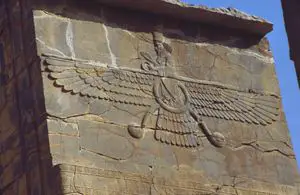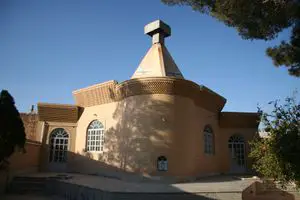What is Zoroastrianism
Zoroastrianism was one of the most important religions in the ancient Near East and is still practiced by over 100,000 people around the world; but it also happens to be one of the more misunderstood religions in history. Originating in ancient Persia probably in the middle of the second millennium BC, Zoroastrianism gradually spread through the words of its prophet, Zarathustra, or Zoroaster, before becoming the primary religion of the Achaemenid, Parthian, and Sasanian empires. The religion became known as Zoroastrianism and as is the case with so many other religions, it evolved over time and adapted to the circumstances of its environment.
An examination of the ancient sources reveals that when the Achaemenid kings began worshipping Ahuramazda, the primary Zoroastrian god, the religion they followed was far different than what it later became. The Parthians refined many of the Achaemenids’ theological ideas and then the Sasanians codified the rituals and myths, essentially turning an obscure Indo-European cult into a true revealed religion. After the Islamic conquest of Persia in the seventh century, Zoroastrianism waned, but many of its strictest followers left for India where they were allowed to worship Ahuramazda openly.
Who was Zarathustra?
In order to understand the development of Zoroastrianism, one has to start at the beginning with the religion’s prophet, Zarathustra. Zoroastrianism shares a commonality with the Abrahamic religions as well as Buddhism and Sikhism in that they are all revealed religions. In the case of Zoroastrianism, the prophet who received the word of god was a Persian named Zarathustra, or Zoroaster as it is sometimes spelled in the West. Zarathustra’s life is largely a mystery, as there are no non-Zoroastrian texts that offer any insight into his birthplace or even when he lived.
Most modern scholars believe that Zarathustra lived between 1400 and 1200 BC, [1] although the Sasanian sources claimed that he lived much later, only 258 years before Alexander the Great, [2] which would have been some time just before the Achaemenids created their empire around 600 BC.
Zarathustra’s background is not as important as what he believed and preached as he traveled throughout Persia. Contrary to common belief, Zoroastrianism is not nor ever has been a monotheistic religion. Zarathustra and all of his subsequent followers believed in an Iranian triad that was heavily influenced and related to the Vedic religion of ancient India. Ahuramazda is the god at the head of the triad, which included Varuna and Mithra. [3] Ahuramazda was/is the god primarily worshipped by Zoroastrians, although Mithra and numerous angels/demi-gods also play a role. Mithra would later be adopted by the Romans and become one of their more popular gods.
What is Zoroastrian Theology?
At the center of Zoroastrian theology is the belief in asha, which can best be translated as a combination of righteousness, truth, and order. Zoroastrians are mindful of asha in everything they do, ritual or otherwise, and strive to avoid its opposite concept, drug, or “the lie.” [4] As Zoroastrians carry on their daily lives with the idea of asha in mind, pious believers have also carried out a number of notable rituals for centuries.
Sacred fires have been an important component in Zoroastrianism almost since its inception and are believed to come from its primordial Indo-European origins. As in the Vedic religion where the deities often had constructive and destructive qualities simultaneously, the Zoroastrian reverence of fire is an extension of this idea. Zoroastrians view fires as representative of purity, asha, and as such they must never be contaminated. The Zoroastrian reverence for fire led to the establishment of sacred fires and fire temples, some of which still exist. [5] Throughout history outsiders have consistently misunderstood the Zoroastrian reverence for fire as worship of fire, although Zoroastrian texts are adamant that fires are only representative of Ahuramazda power.
Another Zoroastrian ritual that has been misunderstood throughout history is the practice of corpse exposure. Zoroastrians believe that evil is omnipresent in the world and that once a person dies the corpse needs to be destroyed so that the soul will not be infected with evil. [6] The practice has generally involved priests bringing the body to a “Tower of Silence” where it was/is exposed and left to be eaten by dogs and vultures. The priest would then gather then bones and place them in an ossuary. The earliest recorded observation of this practice was made by the fifth century BC Greek historian, Herodotus. He wrote:
“There is another practice, however, concerning the burial of the dead, which is not spoken of openly and is something of a mystery: it is that a male Persian is never buried until the body ahs been torn by a bird or dog.” [7]
It should be pointed out that the practice is not confined to men and that traditionally male and female Zoroastrians have been given this funerary rite. [8]
Where the Achaemenid Persians Zoroastrians (559-330 BC)?

There is a debate among modern scholars concerning whether or not the Achaemenid Persians can be considered true Zoroastrians. Some refuse to classify them as such, [9] while others believe they were, or were at least proto-Zoroastrians. [10] Based on the historical evidence, there is evidence to support either argument.
In terms of burial rituals, the Achaemenid kings were interred in tombs, which is clearly not in keeping with the Zoroastrian ritual of corpse exposure, [11] although later Persian dynasties that were considered true Zoroastrians also interred their kings. Other scholars have also pointed out that Cyrus and Cambyses preferred Mithra to Ahuramazda, [12] but Darius I “the Great” (ruled 525-486 BC) invoked Ahuramazda’s named in nearly everyone of his royal inscriptions. An inscription from the capital city of Persepolis relates the importance of Ahuramazda in terms of truth/asha.
“Saith Darius the King: May Ahuramazda bear me aid, with the gods of the royal house; and may Ahuramazda protect this country from a (hostile) army, from famine, from the Lie! Upon this country may there not come an army, nor famine, nor the Lie; this I pray as a boon from Ahuramazda together with the gods of the royal house. This boon may Ahuramazda together with the gods of the royal house give to me!” [13]
Even if one does not consider the Achaemenids to have been true Zoroastrians, they certainly laid the groundwork for what would become the dominant religion in Persia for nearly 1,000 years.
Zoroastrianism As the Religion of Persia
Zoroastrianism suffered a setback after Alexander the Great and his Macedonian army conquered Persia in 330 BC. Less than 100 years later, though, the Parthians (247 BC-AD 224) came to power in Persia and initiated a dynasty that patronized Zoroastrianism as the state religion. The Parthians preserved the oral hymns and verses that would later comprise the holy book of Zoroastrianism, the Avesta, as well as the exegesis texts known as the Zand. [14]
The oldest documented fire temples are also dated to the Parthians. The rituals of tending the sacred fires, which are still practiced today, were established in the Parthian period and the three greatest fires of Zoroastrianism – Adur Burzen-Mihr, Adur Farnbag, and Adur Gushnasp – were all installed under Parthian kings. But the Parthians continued the very non-Zoroastrian Achaemenid tradition of interring their dead, although non-noble Zoroastrians did practice ritual exposure during this period. [15] The Parthians were clearly Zoroastrians, but their successors, the Sasanians (AD 224-651) codified the rituals and myths of Zoroastrianism, putting it on par with the other established religions of the period.
By the time the Sasanians came to power, Zoroastrianism was well-established not just in Persia, but throughout central Asia. The Sasanians saw the need to codify the Avesta in writing and to make sure that the people were following the rituals properly. High priests were appointed to oversee that the proper rituals were being carried out across the somewhat decentralized empire, especially the proper maintenance of the sacred fires. The high-priest Tansar, who served under Ardashir I (ruled 224-240), wrote letters to the regional governors and kinglets to make sure they were following the rules. In one letter, Tansar explains how Ardashir destroyed unauthorized fire temples while protecting the sacred fires.
“The truth is that after Darius (III) each of the ‘kings of the peoples’ [i.e. the Parthians’ vassal kings] built his own [dynastic] fire temple. This was pure innovation, introduced by them without the authority of king of old. The King of kings has razed the temples, and confiscated the endowments, and had the fires carried back to their places of origin. . . In the space of fourteen years. . . he thus brought it about that he made water flow in every desert and established towns and crated groups of villages.” [16]
Ardashir’s reformation also involved removing all icons from the fire temples and reducing the number of regnal fires to one. The king then installed several smaller, non-regnal fires to demonstrate his piety and support for the priesthood. [17]
The final and perhaps most important step the Sasanians took in the evolution of Zoroastrianism was to finally put the oral verses of the Avesta into writing. This process took place during the fifth or sixth centuries and totaled twenty-one books, including the following: gathas (songs), yashts (hymns to Mithra and other lesser gods), and the Vendidad (laws). Copies of the original Avesta, which were compiled in the Avestan language, were all destroyed in the Arab, Mongol, and Turkish invasions of Persia in the Middle Ages, but the Middle Persian, or Pahlavi, Zand of the Sasanians survived. [18] Since the only extant version of the Avesta is the Zand of the Sasanians, it is often called the Zand or Zend-Avesta.
Did Zoroastrianism extend Outside of Persia?
The Arab conquest of Persia not only brought an end to the Sasanian Dynasty, but also to Zoroastrianism’s religious hegemony over the land. The new Muslim rulers “allowed” the Zoroastrians to continue their religion if they paid the onerous jizya tax. The alternatives were to convert to Islam, become a martyr, or flee to new lands. [19]
Many Zoroastrians converted to the new religion, while others fled to remote areas of Iran where they paid the tax and were tolerated and allowed to continue their religion until the present. A large group organized in 917, though, and left for the region of Gujarat, India. There they faced some of the same problems as in Iran, but their Hindu neighbors were generally tolerant of their religion. The Zoroastrians of India eventually became known as Parsis, forming a tightknit community that still exists in the region to this day.
Conclusion
Of all the world’s major religions of the past and present, few have a more interesting history than Zoroastrianism. Arising from obscurity in ancient Iran, the religion was spread through the mouth of a prophet named Zarathustra. Eventually, over the course of 1,000 years, the religion that became known as Zoroastrianism was patronized by powerful dynasties that eventually made it their state religion. But just as Zoroastrianism was reaching its peak in terms of number of followers and intellectual maturity, it was nearly wiped out at the hands of invaders. In a testament to the tenacity of its followers, Zoroastrianism found a new home and continues to have adherents today.
References
- Jump up ↑ Boyce, Mary. Zoroastrians: Their Religious Beliefs and Practices. (London: Routledge, 2007), p. 2
- Jump up ↑ Malandra, William W, ed. and trans. An Introduction to Ancient Iranian Religion: Readings form the Avesta and the Achaemenid Inscriptions. (Minneapolis: University of Minnesota Press, 1983), p. 17
- Jump up ↑ Clark, Peter. Zoroastrianism: An Introduction to an Ancient Faith. (Brighton, United Kingdom: Sussex Academic, 2001), p. 4
- Jump up ↑ Clark, p. 5
- Jump up ↑ Clark, pgs. 93-96
- Jump up ↑ Boyce 2007, p. 44
- Jump up ↑ Herodotus. The Histories. Translated by Aubrey De Sélincourt. (London: Penguin, 1996), Book I, 140
- Jump up ↑ Clark, p.114-16
- Jump up ↑ Malandra, p. 24
- Jump up ↑ Clark, p. 56
- Jump up ↑ Clark, p. 57
- Jump up ↑ Briant, Pierre. From Cyrus to Alexander: A History of the Persian Empire. Translated by Peter T. Daniels. (Winona Lake, Indiana: Eisenbrauns, 2002), p. 94
- Jump up ↑ Kent, Roland, ed. and trans. Old Persian: Grammar, Texts, Lexicon. Second Edition. (New Haven, Connecticut: American Oriental Society, 1953), p. 136, DPd
- Jump up ↑ Boyce, Mary, ed. and trans. Textual Sources for the Study of Zoroastrianism. (Chicago: University of Chicago Press, 1990), p. 23
- Jump up ↑ Boyce, pgs. 86-90
- Jump up ↑ Boyce 1990, pgs. 109-10
- Jump up ↑ Boyce, pgs. 106-8
- Jump up ↑ Boyce 1990, pgs. 1-4
- Jump up ↑ Clark, p. 89



